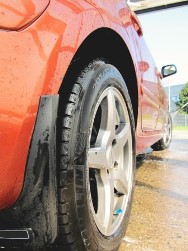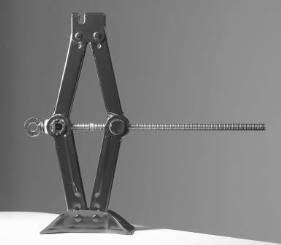Do you know how to change a car tyre? KennCo Insurance includes breakdown assistance with all of our car insurance policies as standard. One of the most common call outs requests that we receive is to change a car tyre. Causes of punctured tyres include incorrect tyre pressure, sharp objects and worn tyres to name a few. Our breakdown assistant repairers are usually out to an incident within the hour. But what happens if you phone is out of coverage or you’re travelling with someone who doesn’t have breakdown assistance?
We’ve created a step by step guide on how you can change a car tyre correctly and safely.
Identifying a Punctured Tyre
Deflated Car Tyre
Having a deflated tyre, doesn’t always mean that your tyre is punctured. If your car hasn’t been used in the while, the tyres may deflate slightly. When you re-inflate you tyres, they should maintain their air pressure without needing to be repaired.
Slow Tyre Puncture
If you re-inflate your car tyre and notice that the air pressure reduces again after a couple of days, you may have a slow puncture. This can usually be fixed at your local tyre garage for approximately €12. After you inflate your tyres, you can drive to the garage yourself and the air pressure reduces very gradually. You should aim to mend you tyre as soon as you notice that it has a slow puncture, as driving on a damage tyre can be dangerous and may result in the puncture becoming larger and more costly to mend.
Sudden Tyre Puncture
In the event of a sudden puncture, the steering on your car will adjust abruptly. Your steering wheel will become more difficult to turn and your control of the car will be greatly reduced. Some cars even have a tyre pressure monitoring system that tells you if your tyre press has dropped in a particular tyre. If this happens, try to slowly manoeuvre your car to the side of the road and stop as soon as possible. The longer you drive on a punctured tyre, the more damage it creates. If you continue trying on a punctured tyre, you may even damage the rim of the wheel.
Changing a Punctured Tyre
Preparing your Car
- Once you’ve pulled over to the side of the road, ensure that the hand-break is applied and that the car is in first gear.
- Most cars come with safety triangles included now so you should place up to 15-20 metres away from your car.
- It’s also a good idea to keep a Hi-Vis vest in the boot of your car to wear in such instances.
- Before you start taking off the punctured tyre, check that you have a spare tyre that is fully inflated and unload from car along with necessary tool including car jack, tyre bolts pin (if required), wrench.
Removing the Punctured Tyre
Removing hubcaps or nut covers
Before you can start to unscrew the wheel bolts, you will usually need to remove either the car’s hubcaps or nut covers.
- Hubcaps are sometimes secured using cable ties, so to cut these off, you will need a sharp knife or scissors. Once these are off, pry around the edges of the hubcap with a screwdriver and apply pressure until it pops away from the tyre. If you feel that the hubcap is going to break, move to a different spot before reapplying pressure.
- Nut covers are usually found on alloy wheels and are used as an anti theft measure and for aesthetics reasons. Most covers can be removed by using a wire removal hook. This small wire pin is usually found along with the rest wheel repair equipment in your boot. Please consult your owner’s manual for the exact location. To remove the nut covers, insert the pin into the nut cover and pull until the cover detaches.
Once you have removed any covers over the wheel nuts, you can then start to loosen the nuts. You should loosen the nuts before you jack the car up. But do not totally loosen the wheel nuts or remove them until the car has been raised up using the car jack. Removing the car nuts before the car is raised, may result in the tyre unexpectedly falling off and causing injury or car damage. When you loosening the nuts, you start on the first one and move to the opposite secondly and so on.
Jacking up your car
Try to ensure that you car is on a flat surface before you jack your car up. If possible, place a block or log in front of the two wheels at the opposite end of the car you are lifting.
Correct jack point
Before you lift up the car with the jack, you will need to locate the correct area to place the jack. Your car has certain areas that are reinforced so that they can take the weight of the car. If you use the jack in the wrong area, it may cause damage to the outside of your car. These areas are usually on each side of the car beside the wheels but your user manual will specify the exact points.
Removing the punctured tyre
Once your car has been raised off of the ground, remove the nuts that have already been loosened and lift the tyre from the wheel. Tyres can be heavier than you expect so to protect your back by bending your knees instead of your back. Keep the wheel nuts safe as your move the punctured tyre out of the way. Wait until the car has been lowered before you place the punctured tyre back into your boot.
Placing the spare tyre on the wheel
- Position the spare tyre in front of the wheel and lift the tyre onto the bolts.
- Screw the first nut on followed by the opposite nut and so on. Tighten the nuts enough to keep the tyre in place but do not use excessive force while the car is still suspended on the jack.
- Lower the jack slowly and remove the jack from underneath the car.
- Tighten the nuts as much as you can.
Tyre change follow up
Visit a tyre garage as soon as you can. Spare tyres are of poorer quality than you original tyre and have a speed restriction of 80km/h. Get your old tyre mended and refitted to your car at a garage . Place your spare tyre back in your boot for future use.
There you have it. You now know how to change a car tyre.
Want to reduce the chances of having to change a car tyre? Check our out blog on tyre maintenance.



